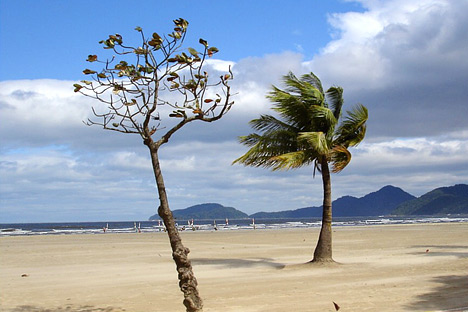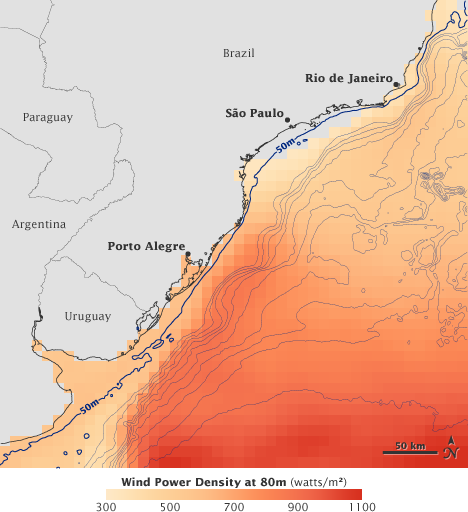

Pimenta’s professor Willett Kempton pointed out two limitations with QuikSCAT’s measurements of wind speed. First, the satellite only measures winds in any given place once per day, far less information than buoys provide. “With buoy data, you can get down to five-minute or even one-minute time resolution,” says Kempton. Since winds are variable, power companies need to know how frequently they can expect lulls when power can’t be produced and how long those lulls might be.

Shifting breezes complicate estimates of energy production from wind power for a given location. Pimenta used local measurements along the Brazilian coast to complement QuikSCAT satellite data to better predict wind energy potential. (Photograph ©2005 by rps.net.)
The other limitation of QuikSCAT was the nature of the measurement itself. “Satellite data is inferred. It’s one more step away from what is actually happening,” says Kempton. By contrast, a buoy records wind speed directly. “You’ve got the wind turning the shaft of an anemometer, and then the anemometer shaft speed tells you the wind velocity,” says Kempton. The satellite observes waves on the ocean to calculate wind speed. “There are more things that can intervene and throw off that measurement.”
For all that, satellite wind data had tremendous potential. Most importantly, QuikSCAT provides wind speed estimates for the entire ocean, worldwide, including coastal Brazil. Second, the data are publicly available for free. Finally, QuikSCAT had been observing winds for more than eight years. “Eight years of global coverage of wind is amazing,” says Pimenta.

NASA scientists used satellite wind measurements to estimate the available wind energy over the ocean, called power density. Blue represents areas with little potential wind power, red indicates locations with high potential for power. To be cost-effective, offshore wind farms must be located near population centers in shallow waters with high power density. (NASA image created by Jesse Allen, using QuikSCAT data from Timothy Liu, Wenqing Tang, and Xiaosu Xie, NASA/JPL.)
“Eventually, we just tried QuikSCAT,” says Pimenta. He compared QuikSCAT measurements of wind speed to measurements taken at the same time by the one buoy that had been in operation during the QuikSCAT record. The two matched reasonably well—close enough, his professor told him, to do a first estimate of the power potential. He extrapolated QuikSCAT measurements of wind speeds at 10 meters above the surface of the ocean to wind speeds 80 to 100 meters up, the height of the wind turbine’s hub. He calculated the amount of power existing turbines would produce at those speeds, and then averaged these measurements to get an estimate of power production throughout the year. In the end, he came up with a map of turbine power output for a wide swath of coastal waters off southeast Brazil.

Pimenta compared measurements of wind speed measured by a buoy (blue line) with satellite data (purple dots) to confirm the accuracy of QuikSCAT. (Graph adapted from Pimenta et al., 2008.)
But knowing how much power the winds could provide was not enough to make a practical estimate of the wind potential of the area. Pimenta also had to know how many turbines could actually be built off the Brazilian coast. Wind farms can’t be built in shipping lanes or bird flyways or near scenic coastlines. Current turbine technology can’t be installed in waters deeper than 50 meters, though companies are beginning to invest in floating turbines. Pimenta superimposed the wind data onto a map of the ocean floor to identify suitable locations for wind farms. This allowed him to calculate how many turbines could be installed off the southeast coast of Brazil. If the suitable areas were fully developed with existing technology, Pimenta estimated that offshore wind farms could produce 102 gigawatts of power on average. Brazil’s average national power need in 2008 was about 100 gigawatts.

Current offshore wind turbines must be in water no more than 50 meters deep. Pimenta combined his estimates of wind power density at 80 meters above the surface with ocean depth measurements (blue lines) to find nearshore areas with high winds and shallow water. His analysis shows a promising location for a wind farm near the city of Porto Alegre, Brazil. (NASA map by Robert Simmon, based on data from Felipe Pimenta.)
After turning in his final project, Pimenta published his results in Renewable Energy in June 2008. No one has contacted him yet about developing an offshore wind farm in Brazil, but the possibility is real. It has happened to other students who have taken Kempton’s course. “A developer decided where to site a billion dollar plus project based on data that was produced in one of our classes,” says Kempton. “We have some very good students. I show them how to do it and let them go.”